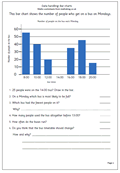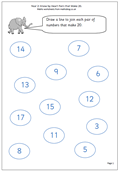 This week it is a page from our year 2 worksheets which looks at pairs of numbers which make 20. Before doing this children should be confident with, and know by heart, all pairs of numbers which make 10. Once they know these, pairs that make 20 becomes easy; just one of each pair is ten more e.g. 6 and 4: 16 and 4. Being able to work quickly with mental arithmetic is one of the keys to success in school as so much of the maths lesson today is carried out orally and children gain or lose confidence very quickly when answering in front of a whole class.
This week it is a page from our year 2 worksheets which looks at pairs of numbers which make 20. Before doing this children should be confident with, and know by heart, all pairs of numbers which make 10. Once they know these, pairs that make 20 becomes easy; just one of each pair is ten more e.g. 6 and 4: 16 and 4. Being able to work quickly with mental arithmetic is one of the keys to success in school as so much of the maths lesson today is carried out orally and children gain or lose confidence very quickly when answering in front of a whole class.
Category: Resource of the Week
Resource of the Week: Decimals that make 10
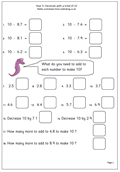 Here we have mental arithmetic maths worksheet on decimals, most suitable for Year 5. This page looks at pairs of decimals that make 10. Once again there are several ways of tackling these questions.
Here we have mental arithmetic maths worksheet on decimals, most suitable for Year 5. This page looks at pairs of decimals that make 10. Once again there are several ways of tackling these questions.
One way is to add on from the smaller number, firstly, the tenths to make the next whole number, and then the units to make 10.
eg 10 – 6.7
Count on from 6.7 to 7 which is 0.3
Then count on from 7 to 10 which is 3
Answer 3 + 0.3 = 3.3
Another way is to count on the units first and then the tenths, but beware the answer which counts on 4 from 6 to make 10 and than counts on 0.3 as this will result in an answer which is one too many: a common slip-up.
Another way of doing this is to ignore the decimal and think of the question as 100 – 67. Work it out mentally (which is 33) and then convert back to 3.3.
Resource of the Week: Adding decimals mentally
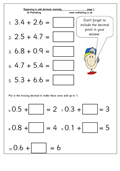 Mental arithmetic is the key to success with calculating. At first glance you might reach for a pencil to do a sum such as 2.5 + 4.7. However, the Primary Framework for Maths suggests that children should be competent in adding two 2-digit numbers in their heads, and there is no reason why, with a little practice this can’t include adding two decimals. The most common approach is almost identical to adding tens and units. Continue reading “Resource of the Week: Adding decimals mentally”
Mental arithmetic is the key to success with calculating. At first glance you might reach for a pencil to do a sum such as 2.5 + 4.7. However, the Primary Framework for Maths suggests that children should be competent in adding two 2-digit numbers in their heads, and there is no reason why, with a little practice this can’t include adding two decimals. The most common approach is almost identical to adding tens and units. Continue reading “Resource of the Week: Adding decimals mentally”
Resource of the Week: Year 4 data handling
Most of the worksheets that you see free online are for numbers and calculating, as these are the easiest to produce. However, mathsblog has an excellent range of worksheets across all areas of maths, including data handling. Here is a page on interpreting bar charts, which also uses the 24 hour clock. it is important to point out that charts such as these must have a proper title and that the axes must be labelled. When children produce their own bar charts they often forget to do this labelling.
When looking at a bar chart one of the first things to do is work out how the numbers are being represented. In this case the number of people on the bus is shown in blocks of 10 and half way between would be a block of 5.
Year 6 maths worksheet: Reading decimal fractions
By Year 6 children should have a good understanding of place value, including decimals. Decimal fractions are often best taught in the context of money, but this only covers tenths and hundredths. This maths worksheet looks at thousandths as well. There two main parts: firstly, writing the value of decimal fractions in words and secondly, writing decimals in digits using the decimal point correctly.
Just like whole numbers a digit becomes ten times smaller when it is moved one place to the right after the decimal point, so the digit 6 in 0.467 is 6 hundredths and the 6 in 0.356 is 6 thousandths.
Resource of the Week: Year 4 Find a difference
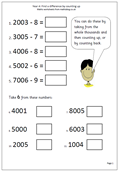 Sometimes a simple question can reveal a great deal about how children deal with numbers. This maths worksheet on finding differences is full of such questions.
Sometimes a simple question can reveal a great deal about how children deal with numbers. This maths worksheet on finding differences is full of such questions.
Let’s look at 3005 – 8 which is easier to do mentally than on paper.
There are several ways that this can be done.
1. Count down, one at a time, 8 from 3005, saying each number as you go. Fingers may be held up on each count down until 8 is reached.
3004, (1), 3003 (2), 3002 (3), 3001 (4), 3000 (5), 2999 (6), 2998 (7), 2997 (8)
2. A different way is to take the 8 from 3000, then add 5.
3000 – 8 = 2992
2992 + 5 = 2997
3. A third way is to take 5 off the 8 leaving 3.
Then take 3 off 3000 = 2997
It is well worth talking to children about how they do this kind of question and what strategies they employ. Much will depend on their knowledge of number.
Resource of the Week: subtraction
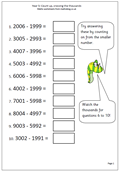 There are many occasions when a 4-digit subtraction can be done ‘in your head’. These questions, suitable for Year 5, are examples of this. They all involve numbers which are just over and just under a whole thousand.
There are many occasions when a 4-digit subtraction can be done ‘in your head’. These questions, suitable for Year 5, are examples of this. They all involve numbers which are just over and just under a whole thousand.
For example: 3003 – 2994
Probably the easiest way to do this mentally is to count on 7 from 2993 to make 3000 and then count on, or add, the extra 4, making 11.
This is much easier than doing the question on paper, with lots of ‘borrowing’ and carrying, crossing out etc!
We have a growing number of pages on mental subtraction including this:
Resource of the Week: Reading the time
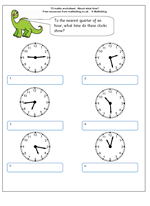 This maths worksheet on reading time to the nearest quarter of an hour highlights several issues which create problems for children.
This maths worksheet on reading time to the nearest quarter of an hour highlights several issues which create problems for children.
Firstly, on the clock face the hours are clearly numbered but the minutes are not and children need to be able to count on in fives before they can read minutes successfully.
Secondly, when telling someone the time we often approximate, either to the nearest quarter of an hour or the nearest five minutes, even when we can see clearly what the time is to the nearest minute.
Thirdly, when saying the time out or writing it we use several different conventions, as shown on the answer sheet.
Lastly, many children seldom come across this type of clock face, especially if they use digital watches, mobile phones etc., therefore take much longer to work it out – don’t be surprised to find ten year olds unable to read an analogue clock correctly.
Resource of the Week: Moving towards standard written methods of addition
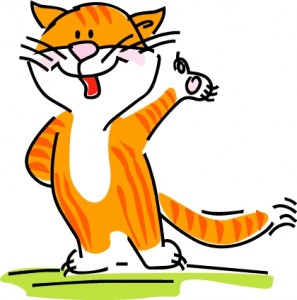 Just one page is not enough for children to become confident with a method, so as often as possible I include at least a second maths worksheet in this case, on ‘moving towards standard written methods’ of 2-digit addition’.
Just one page is not enough for children to become confident with a method, so as often as possible I include at least a second maths worksheet in this case, on ‘moving towards standard written methods’ of 2-digit addition’.
With this method the units are added and placed below the sum, making sure the units are in line and the ten is placed in the tens column. The tens are then added and placed below. The crucial concept here is to remember that it is tens which are being added, so there will be a zero in the units column to ensure that the tens numbers are kept in line. Finally the two answers are added.
This method shows clearly what is happening and should clarify the troublesome ‘carrying’ of the tens when using the standard written method.
Moving towards standard written methods of addition (2)
Resource of the Week: Year 6 fractions vocabulary
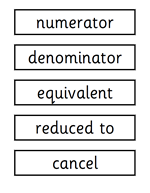 Don’t forget that we have a great range of pages which provide information and printable resources on what is expected in each year group by the primary Framework for Maths. This list contains the key vocabulary for Fractions, decimals, percentages and ratio in year 6.
Don’t forget that we have a great range of pages which provide information and printable resources on what is expected in each year group by the primary Framework for Maths. This list contains the key vocabulary for Fractions, decimals, percentages and ratio in year 6.
Children will have come across all these words in earlier years, but by the end of year 6 (10/11 yr old) they should have a good understanding of all of them
Fraction proper fraction improper fraction
Numerator denominator
Equivalent reduced to cancel
Half quarter eighth
Third sixth ninth twelfth
Fifth tenth twentieth
Hundredth thousandth
Proportion decimal fraction
Decimal point decimal place
percentage per cent %
When spelling, the word twelfth often causes problems. They are all shown in a larger font below if you want to cut them out and print them.
If you are unsure of any of the meanings try one of the free online maths dictionaries such as at
www.mathsphere.co.uk or www.amathsdictionaryforkids.com/
(Taken from Mathematical Vocabulary Book DfEE)
